| Author |
Message |
G Ezell
Industry Professional

Location: North Alabama Joined: 22 Dec 2003
Posts: 235
|
 Posted: Fri 03 Oct, 2008 4:48 pm Post subject: speculation on a sax handle Posted: Fri 03 Oct, 2008 4:48 pm Post subject: speculation on a sax handle |
 |
|
This particular sax has been bugging me since I first saw it. The handle looks to be mostly intact (extremely rare for a sax), but it has some features that just do not make sense. Overall, it would appear that the end of the handle/pommel/upper guard might have roughly mirrored the lower guard/handguard, but then there is that odd thingie stuck there that has me baffled. My theory is it is remains of a sheath/scabbard, and I'd be happy with that (it's a feature seen on several sax), except for the oddness going on at the base of the blade, which also looks to be remains of scabbard fitting, only of a different form of scabbard altogether! It also appears to be solid, which doesn't sit well with the scabbard theory... The inlay at the base of the blade could possibly be the blade itself, swollen by rust, but I find this unlikely. The handle seems to have also experienced swelling, which further complicates any interpretation.
I hope you will look at the images, from Jeroen's excellent ZIP file, and give me your thoughts on what we are seeing here.
All I know of this sax is that it is from the Netherlands, and is dated to 500-700AD. The condition of the blade makes it difficult to tell, but it appears to be a type I, Frankish style, which agrees with the dates. Considering the rarity of saxes with surviving handles, it is an important piece, but difficult to interpret.
 Attachment: 18.14 KB Attachment: 18.14 KB
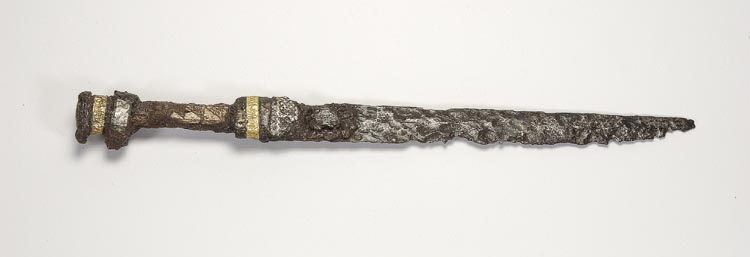
Overall view:
 Attachment: 80.5 KB Attachment: 80.5 KB
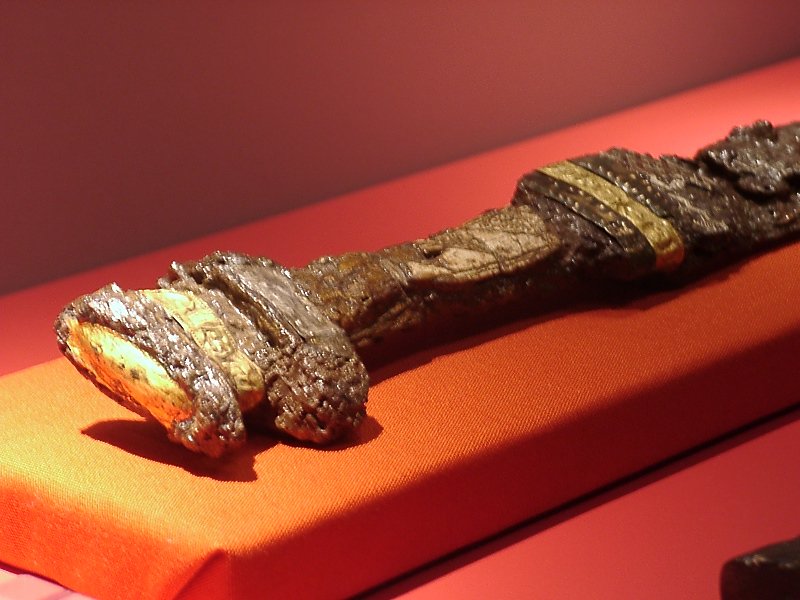
Handle closeup:
|
|
   |
 |
G Ezell
Industry Professional

Location: North Alabama Joined: 22 Dec 2003
Posts: 235
|
 Posted: Fri 03 Oct, 2008 4:54 pm Post subject: Posted: Fri 03 Oct, 2008 4:54 pm Post subject: |
 |
|
Here's a better view of the base of the blade...
 Attachment: 47.61 KB Attachment: 47.61 KB
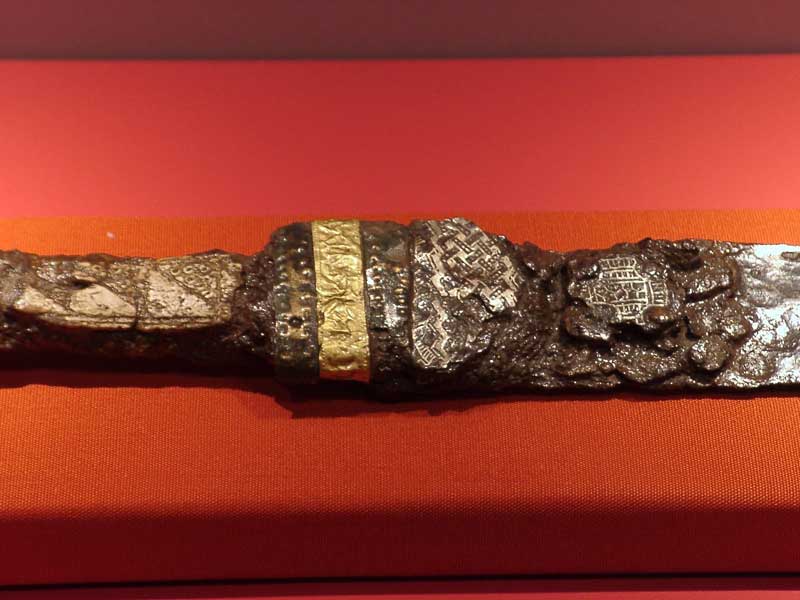
|
|
   |
 |
|
Hadrian Coffin
Industry Professional
Location: Oxford, England Joined: 03 Apr 2008
Posts: 404
|
 Posted: Fri 03 Oct, 2008 6:44 pm Post subject: Posted: Fri 03 Oct, 2008 6:44 pm Post subject: |
 |
|
|
could it be a lower guard to lock your little finger in to keep your hand from sliding up onto the blade? I cant think of any other originals with this configuration, perhaps it is unique. this has me baffled I have seen many originals but none like this, other ideas would be a slid down ring in the grip, or an emulation of a two piece pommel as seen on a sword or a slid down cross guard
|
|
   |
 |
|
Richard Hare
Location: Alberta, canada Joined: 15 Mar 2008
Posts: 135
|
 Posted: Sat 04 Oct, 2008 6:46 am Post subject: Posted: Sat 04 Oct, 2008 6:46 am Post subject: |
 |
|
Very interesting sax.
To me, it looks like the hilt ends just below the gold band, and the silver below this appears to be the remains of a locket, or mouth of a sheath.
The grip has me a bit foxed.
Is that inlay on the grip proper? (The triangles)?
If it is, I don't know what's going on.
If the smaller diameter grip was plain, I'd have said that the bulge below the pommel was a band, which had slipped up to the pommel from the cemtre of the drip, after an organic handle had rotted away.
This would mean that the handle was similar to a later Highland dirk....(which was my first thought........particularly the "shoulders" at the guard end.)
One other thought comes to mind;
Could the bulged piece just below the pomme-piece be some remains of a ring, which encircled the handle, as an aid in keeping the sax in its sheath?........like where the press-stud fastener would be on a modern knife sheath?
I know this sounds far out, but such a ring, mounted on the elongated back of the scabbard, could be flipped over the pommel.
Am I on thin ice?!
Just a thought...
Richard.
|
|
   |
 |
G Ezell
Industry Professional

Location: North Alabama Joined: 22 Dec 2003
Posts: 235
|
 Posted: Sat 04 Oct, 2008 7:31 am Post subject: Posted: Sat 04 Oct, 2008 7:31 am Post subject: |
 |
|
http://en.wikipedia.org/wiki/Image:Seax_merowingian.jpg
Note that on the sax at the link the way the scabbards are made with a metal throat piece. I'm thinking that this could be a similar piece, except for two things; the piece appears to be solid, and the stuff going on at the base of the blade looks like the remains of a different type of scabbard (there seems to have been two different ways to sheath a sax, either like the merovingian sax in the image, or like a sword, as seen on a few German sax, although these German saxes do not appear to have a metal throat piece)
I've seen a few other handle remains that point towards a dirk-like handle for some sax, but the remains are so few and far between it is difficult to reach any real conclusion. I have limited time now, but this afternoon I'll dig up some more images of similar handles. It appears likely that the later brokenback saxes had simple straight handles, but some of these Frankish type appear to have had a swelling at the guard in a way that does remind one of a dirk handle.
brb...
|
|
   |
 |
Ben Potter
Industry Professional

Location: Western Idaho Joined: 29 Sep 2008
Posts: 347
|
 Posted: Sat 04 Oct, 2008 12:00 pm Post subject: Posted: Sat 04 Oct, 2008 12:00 pm Post subject: |
 |
|
My guess would be that the inlaied steel ring around the handle and the just below the lower guard are scabbard fittings and the gold rings are actually on the seax handle. I think that the engraved pieces on the side of the tang are panels that were inlaied into the side of the grip. I did a graphic to illustrate The lighter area would be the rough profile of the scabbard and the darker area would be the handle.
I'm guessing that the lower fitting rusted to the blade.
I'm not convinced about this but it seem to make sense, though I've never seen a sheath like this.
 Attachment: 6.14 KB Attachment: 6.14 KB
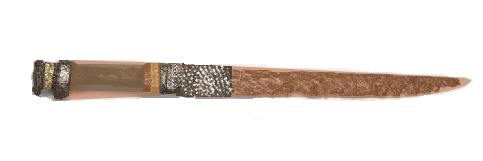
Ben Potter Bladesmith
It's not that I would trade my lot
For any other man's,
Nor that I will be ashamed
Of my work torn hands-
For I have chosen the path I tread
Knowing it would be steep,
And I will take the joys thereof
And the consequences reap.
|
|
   |
 |
G Ezell
Industry Professional

Location: North Alabama Joined: 22 Dec 2003
Posts: 235
|
 Posted: Sat 04 Oct, 2008 9:11 pm Post subject: Posted: Sat 04 Oct, 2008 9:11 pm Post subject: |
 |
|
Thank you all for your replies, I am starting to think it is simply part of the handle that may have slipped out of place slightly, honestly, I don't know.
(I'm hoping we can lure Peter or Jeroen to this thread, I'd like to hear their take on it)
Meanwhile, just for the fun of it, I've put together an image of all the remaining sax handles I could find, in no particular order. Note that this covers virtually all types of sax over a broad range of time. Also, some of these are almost certainly not designed as weapons, some being quite small in size. More than one of these are incomplete.
|
|
   |
 |
G Ezell
Industry Professional

Location: North Alabama Joined: 22 Dec 2003
Posts: 235
|
 Posted: Sat 04 Oct, 2008 9:15 pm Post subject: Posted: Sat 04 Oct, 2008 9:15 pm Post subject: |
 |
|
Let's try that image again...
 Attachment: 65.46 KB Attachment: 65.46 KB
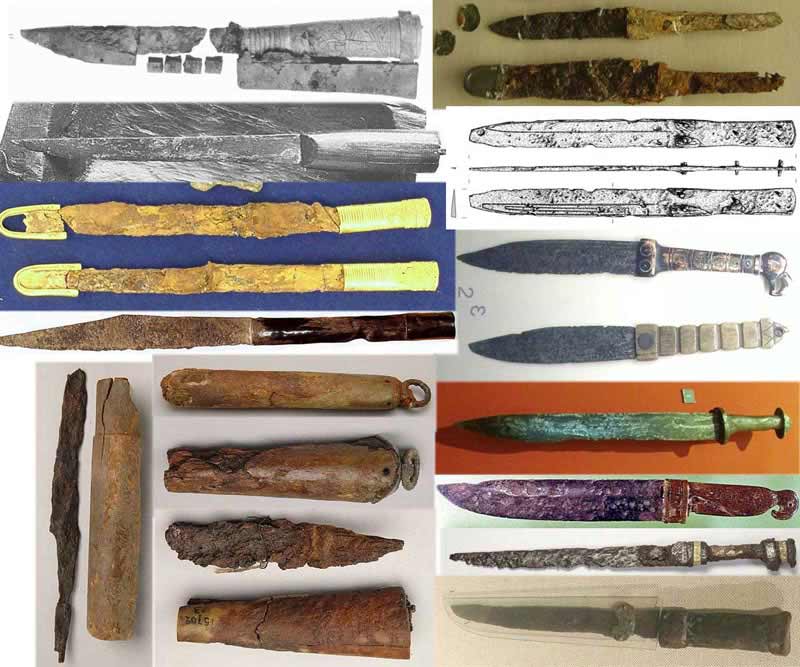
|
|
   |
 |
|
Jeroen Zuiderwijk
Industry Professional
|
 Posted: Tue 07 Oct, 2008 5:13 am Post subject: Posted: Tue 07 Oct, 2008 5:13 am Post subject: |
 |
|
Not sure exactly which parts you are refering to in your question, but the silver inlayed (possibly with niello) on the blade are remains of the scabbard mouth. The pommel seems to be surrounded by a copper alloy strip (may be divided by the gold strip), and a gold band in the middle. The grip is inlayed with bone pieces. No idea what the grip was made off, and what the shape would have been. The pommel is even more a mystery. With such complex and unique pieces as this, it's very hard to interpret what it would have been like originally. AFAIK there are no parallels for this one, aside maybe for the blade shape, which seems to by a very early straight backed small or narrow sax (though quite large for the type, if it is one). I'd say 6th century is probably the best guess for the date.
B.t.w. on the sax composition picture, what's the sax on the wooden box? (second from the top left)
|
|
   |
 |
G Ezell
Industry Professional

Location: North Alabama Joined: 22 Dec 2003
Posts: 235
|
 Posted: Tue 07 Oct, 2008 8:34 am Post subject: Posted: Tue 07 Oct, 2008 8:34 am Post subject: |
 |
|
| Jeroen Zuiderwijk wrote: | Not sure exactly which parts you are refering to in your question, but the silver inlayed (possibly with niello) on the blade are remains of the scabbard mouth. The pommel seems to be surrounded by a copper alloy strip (may be divided by the gold strip), and a gold band in the middle. The grip is inlayed with bone pieces. No idea what the grip was made off, and what the shape would have been. The pommel is even more a mystery. With such complex and unique pieces as this, it's very hard to interpret what it would have been like originally. AFAIK there are no parallels for this one, aside maybe for the blade shape, which seems to by a very early straight backed small or narrow sax (though quite large for the type, if it is one). I'd say 6th century is probably the best guess for the date.
B.t.w. on the sax composition picture, what's the sax on the wooden box? (second from the top left) |
Thank you for your input on this. The second from the top left sax, the only information I have is that it's from Oseberg (not sure if was found on the ship or from a different excavation). I cannot recall where I found the image. It's similarity to some modern Scandinavian knives is striking. The image has it sitting atop a wooden bowl.
The pommel and it's structure was the part I was referring to, the part that appears to be silver, in particular. I was thinking it could be part of the scabbard, like the ring seen at the throat of the scabbards on the merovingian examples. However, if the silver inlayed area at the base of the blade is the remains of a scabbard mouth, it's unlikely that this was also part of a scabbard. The pommel seems to mirror the other end of the handle, except for that particular piece. Stylistically, it does bear some similarity to the saxes on the right of the image, with the narrowing of the grip past the guard area. The pommel, however, seems unique among the few we have to compare it to. The sax on the bottom right for the composite image is another that I find intriguing, the simple wooden handle does bear some resemblance to it, although not as richly made.
Again thank you all for your replies.
|
|
   |
 |
Ben Potter
Industry Professional

Location: Western Idaho Joined: 29 Sep 2008
Posts: 347
|
 Posted: Tue 07 Oct, 2008 10:59 am Post subject: Posted: Tue 07 Oct, 2008 10:59 am Post subject: |
 |
|
Could the inlayed steel on the blade have been to hold the scabbard in the right shape, like a clamp to bring the leather in under the hilt?
Thanks for all the pictures.
Ben Potter Bladesmith
It's not that I would trade my lot
For any other man's,
Nor that I will be ashamed
Of my work torn hands-
For I have chosen the path I tread
Knowing it would be steep,
And I will take the joys thereof
And the consequences reap.
|
|
   |
 |
G Ezell
Industry Professional

Location: North Alabama Joined: 22 Dec 2003
Posts: 235
|
 Posted: Thu 16 Oct, 2008 10:21 am Post subject: Posted: Thu 16 Oct, 2008 10:21 am Post subject: |
 |
|
This is a rough 3D sketch showing the general form of the handle as it might have looked before being buried, with the 'questionable' parts removed, and the inlay not shown. It is only a best guess on my part, it assumes the band seen near the pommel and the silverwork at the base of the blade are remains of the scabbard/sheath. After spending too much time looking at it, it seems possible the entire handle may have been bone slabs sandwiching the tang, although it could be overlay over a wooden core, or a band of inlay over wood. I'm assuming again that in the pommel area, the wood (bone?) has swelled as the bronze bands corroded in this area. Too much assumption on my part... There must be published data from the find available, somewhere, that could shed light on this most odd sax.
For your amusement, my sketch...
Ben, I think you are likely correct, it is a feature seen occasionally on sax sheaths...
 Attachment: 48.51 KB Attachment: 48.51 KB
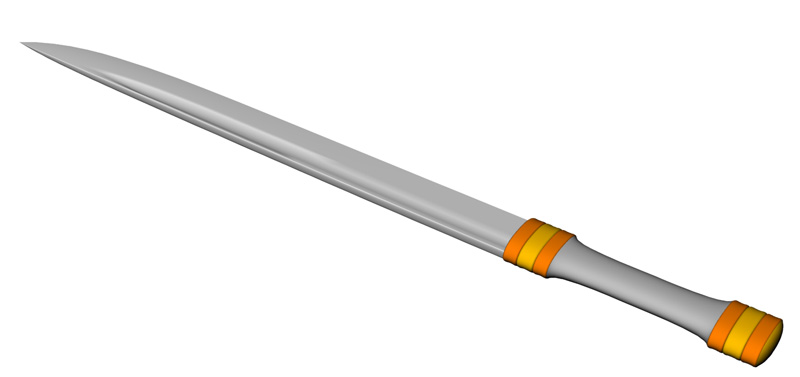
|
|
   |
 |
G Ezell
Industry Professional

Location: North Alabama Joined: 22 Dec 2003
Posts: 235
|
 Posted: Thu 12 Feb, 2009 11:15 am Post subject: Posted: Thu 12 Feb, 2009 11:15 am Post subject: |
 |
|
http://mis.historiska.se/mis/sok/include_image_exp.asp?uid=224070
http://mis.historiska.se/mis/sok/include_image_exp.asp?uid=224071
I found this while looking for something else. One of the best surviving handles I've found, thought I'd add it to the images I posted already, for the sake of completeness.
Notice the rivets on the grip, very interesting.... it may have once been leather covered. The pommel is fascinating, similar to swords of the same age, yet not. Not quite sure of the materials involved, the wraps appear to be bronze, the handle itself could be wood or maybe horn. Vendel period, the blade is in bad state but appears to be the straight-backed variety. I wish I had it's measurements.
" I have found that it is very often the case that if you state some absolute rule of history, there will be an example, however extremely unusual, to break it."
Gabriel Lebec
https://www.facebook.com/relicforge
|
|
   |
 |
|
Peter Johnsson
Industry Professional
|
 Posted: Thu 12 Feb, 2009 1:28 pm Post subject: Posted: Thu 12 Feb, 2009 1:28 pm Post subject: |
 |
|
This is one of the seaxes from Bjärs, Gotland. ( To be exact: Bjärs, grave 27)
It is a Vendel period weapon, that shares some similarities with those found in Valsgärde: decorative rivets set in grip, decorative rivets set in scabbard as well as bronze plates and decorative carving in the wood. The ferrules of the grip are unique, although this "wing nut" shaped rivet block appears in many different guises on seaxes and knives over a wide time period and geographical area. You find them on personal knives in scandinavia in the late roman iron age and it is a surviving feature on contemporary finnish Puukko knives (although then made in one with the pommel).
Measurements on the Bjärs 27 seax is:
Blade length: 43 cm (originally about 45 cm)
Blade width: 3 cm
Grip length: 10.5 cm
Surviving length of scabbard: 50 cm (but was originally longer) and width: 4.5 cm
The scabbard for this knife did not enclose the grip, but left it wholly exposed. It was made of wood slats and reinforced with bronze plates and domed rivets, carved with highly abstracted zoomorphic decorations.
I think Bjärs 27 can be classified as a Schmalsax (narrow seax) even though it is slightly long for the type (they tend to be 22-40 cm long). I don´t remember the official dating of this knife, but at a guess, late 6th C.
I have not read the report on the Bjärs finds, only browsed through Per Olsén: Die Saxe von Valsgärde, where many examples are shown and described, including the Bjärs 27. Data is from that publication.
|
|
   |
 |
G Ezell
Industry Professional

Location: North Alabama Joined: 22 Dec 2003
Posts: 235
|
 Posted: Thu 12 Feb, 2009 3:34 pm Post subject: Posted: Thu 12 Feb, 2009 3:34 pm Post subject: |
 |
|
Thank you very much Peter for the information!
I'll have to find a copy of Per Olsén: Die Saxe von Valsgärde, I would very much like to see more of these.
" I have found that it is very often the case that if you state some absolute rule of history, there will be an example, however extremely unusual, to break it."
Gabriel Lebec
https://www.facebook.com/relicforge
|
|
   |
 |
G Ezell
Industry Professional

Location: North Alabama Joined: 22 Dec 2003
Posts: 235
|
|
   |
 |
|
Jeroen Zuiderwijk
Industry Professional
|
|
   |
 |
G Ezell
Industry Professional

Location: North Alabama Joined: 22 Dec 2003
Posts: 235
|
 Posted: Thu 26 Feb, 2009 3:09 pm Post subject: Posted: Thu 26 Feb, 2009 3:09 pm Post subject: |
 |
|
http://translate.google.com/translate?hl=en&a...2%26sa%3DG
That's the page I found the first one on, translated by google. The site appears to be on the Finnish coast. There is also a sword with a very odd pommel, i believe from the same grave. This is the text that accompanies the photo, again crudely translated thanks to google...
"Mount to backsword, skramasax. Svärd type is also known as weapons knife or chopping knife. Skramasaxen is the blade and drew a total of 63 cm long. The blade is about 4 cm wide and only slightly wider at the center and is thus suitable both as stab and stick arms. The blade tip tapered steeply from back to edge and not the other way around like a knife. In parallel with the back and edge are four engraved straight furrows. Skramasaxar found including in Southwest Finland and considered to be of Finnish origin are shorter, blade is significantly wider in the middle than at the hilt and has a straight back and curved edge. Among the finds from Pukkila in Storkyro Hackman describes a skramasax (about 73.5 cm) with similar grooves engraved on skramasaxen from Pörnullbacken, but with engraved animal ornamentation of the dangers. Pukkilafyndets blade also differs from the current skramasaxen by blade tapered from the middle. Moreover, the conserved parts of the bracket about chopping knives from Ristimäki in St Karins and pitkä Mäki in Lieto. A skramasax (46 cm) from Kapar Kullen in Vörå, opposite Pörnullbacken, have straight backs and dated by Hackman to merovingertid. Skramasaxar has also been found on Viskusbacken and Lövbacken in Vörå. Skramasaxen from Pörnullbacken may be related to Gotland, where skramasaxar under Edgren occur in graves from the viking age (900's), but only exceptionally in Finland. Skramasaxar from this period are also present in Norway. The tip-shaped oval at the bracket "Holker" should be able to give guidance on where the eneggade sword from Pörnullbacken manufactured and on a more precise dating. Probably can skramasaxen including on the basis of findings case dated to the early viking age, ie 800-tal. Photo Mikael Manor."
What I find striking is the similarity of the fittings of this sax with the one from Bjärs, Gotland.
The other sax, with the wooden handle (and what appears to be an iron pommel-cap), is from Lake Lucerne, Switzerland, no information on the date.
" I have found that it is very often the case that if you state some absolute rule of history, there will be an example, however extremely unusual, to break it."
Gabriel Lebec
https://www.facebook.com/relicforge
|
|
   |
 |
|
|
You cannot post new topics in this forum
You cannot reply to topics in this forum
You cannot edit your posts in this forum
You cannot delete your posts in this forum
You cannot vote in polls in this forum
You cannot attach files in this forum
You can download files in this forum
|
All contents © Copyright 2003-2025 myArmoury.com — All rights reserved
Discussion forums powered by phpBB © The phpBB Group
Switch to the Basic Low-bandwidth Version of the forum
|

